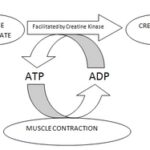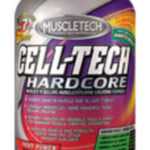What is Creatine?
Creatine monohydrate is one of the most widely used performance enhancing supplements on the market, especially among competitive athletes and weightlifters. Creatine Monohydrate is naturally produced in the skeletal muscles of the body, but can also be found in food such as red meats. The main use of creatine within the human body is to provide energy; the creatine-phosphate energy system is responsible for much of the body’s immediate energy or ATP (adenosine tri-phosphate) production necessary for muscle movements for short bursts of time without the use of oxygen. After body movement has been powered by the creatine-phosphate energy system for several seconds, eventually the oxidative energy systems take over to produce energy more effectively, for a longer amount of time.
How can Creatine supplementation benefit the user?
Creatine supplementation has existed for over twenty years. The idea behind creatine supplementation is that if you saturate the skeletal muscles with creatine, you may be able to expand the threshold of your creatine-phosphate energy system. This would theoretically allow the person supplementing creatine monohydrate to recover faster between short bursts of strenuous activity and also sustain energy production by the creatine-phosphate energy system for a slightly longer time.
These theoretical results are a clear benefit in many athletic activities which utilize the fast energy systems such as the creatine phosphate energy system. During sprints, where the creatine-phosphate energy system is the main way of producing ATP for muscle movements, supplementation could be beneficial during training by allowing faster recovery between successive sprint training intervals, or during competition by allowing a person to provide more power through their muscles for a slightly longer time. Because of these training and performance benefits, creatine monohydrate has been a widely used supplement during the past couple decades.
How can Creatine monohydrate be supplemented?
Generally a person will consume one 5 gram serving of creatine monohydrate, mixed with a sugary beverage to allow fast absorption, per day. However, for the first 5 days of taking creatine a person must saturate their muscles with creatine, so generally 4-7 doses (5 grams), depending on size, of creatine monohydrate should be taken throughout the day. This five day “loading” cycle will saturate your skeletal muscles with as much creatine as they can hold, and afterwards only the daily 5 gram serving will be needed to maintain elevated creatine levels in the muscles, by replacing the creatine used during athletic activities. Maintenance creatine servings are generally best taken after a workout, when stores of creatine within muscles are the lowest, to replenish them. Most people choose to supplement creatine for a period of 6-8 weeks, and then take a break for a month or two to ensure that the body will not lose its ability to produce creatine within skeletal muscles. A key thing to note when supplementing creating-phosphate is to remember to drink a lot of water. Muscles are composed of approximately 70% water, and water provides more room for storage of creatine within the muscles.
What are the Side-effects of Creatine Supplementation?
Aside form the desired effects of creatine supplementation such as increased anaerobic capacity and faster recover between sprint-like activities very few side-effects have been noted. Many studies have shown that over an extended amount of time, the amount of lean body mass added from weight-lifting was higher when supplementing creating-monohydrate than in the control group. Additionally an increase in added water retention within muscles has been noted in many studies, but this seems to quickly subside when a subject stops supplementing creatine monohydrate. The last noted side effect was noted in one particular study where a few of the participants suffered form diarrhea. However it was later discovered that the football players in the study had been taking many times the recommended serving size in an attempt to gain more benefits. While most major studies have showed very little to no signs of side-effects, no long term research has been done to show the long term effects that creatine supplementation can cause.
Personal Results:
During my senior year in High School I began supplementing creatine monohydrate in an attempt to put on more muscle mass. I followed the procedures previously listed, mixing my creatine monohydrate with Gatorade. While taking creatine, no abnormally large gains in strength were noticeable; however, I was able to break through many lifting plateaus I had reached. I did gain a noticeable amount of water weight, which gave the false illusion that I had put on much more muscle than I actually had, before I knew better. I experienced no adverse side-effects, and upon stopping my supplementation lost the water weight. After the water weight was gone, I had gained a few pounds lean muscle, but I can not be sure if I would have gained the same amount without creatine supplementation. In summation, I feel that the effects of creatine-monohydrate supplementation are not as strong as some may claim, however creatine supplementation was affective in helping me to breakthrough many plateaus I had reached on my lifts. For this reason I would be more likely to recommend it to someone who has already been lifting or training for an extended amount of time rather than a casual lifter/trainer or someone who has just begun an organized routine.



